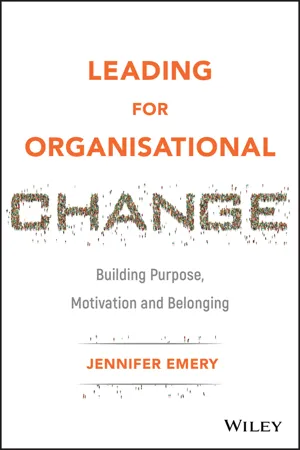
Leading for Organisational Change
Building Purpose, Motivation and Belonging
- English
- ePUB (mobile friendly)
- Available on iOS & Android
About This Book
Harness the seven key elements of successful organisational change
Leading for Organisational Change is an intelligent and practical guide to the human side of merger integration and other organisational change. Building a clear sense of common purpose and then reinforcing it through storytelling can underpin the success of an integration or significant change programme. Pulling together the best thinking from neuroscience, psychology and business, and her rich personal experience in twenty years of leading change projects in professional services organisations and other people-centred businesses, author Jennifer Emery presents a framework for change rooted in seven key themes that help organisations establish their BECAUSE: belonging, evolution, confidence, agility, understanding, simplicity and energy. Exploring the role each theme plays in the context of change, this insightful and warm book shares real-world examples and provides advice on building purpose and culture and strengthening motivation through listening, empowering and collaborating.
Clear understanding of purpose, powerful communication techniques and carefully planned implementation strategies assist in navigating an often stressful and uncertain period of change, and can even enable organisations to thrive throughout this period. This book encourages you to apply important lessons to your own context, allowing you to:
- Focus on the human, cultural and practical elements of organisational change
- Apply central concepts of communication and motivation to a wide array of situations in your personal and business life
- Understand perspectives on change from a broad range of professional sectors
- Build and strengthen communication skills to promote a sense of shared purpose
Leading for Organisational Change offers a warm and intelligent perspective on the personal and inter-personal factors that contribute to successful integration. An invaluable resource for professional services and people-focused organisations, this book provides advice that can cross sectors and lend insight to any major change programme.
Frequently asked questions
Information
Part One
Foundation
Chapter 1
Once Upon A Time
Winter 2006. Early in the new year. The days short, grey and bitterly cold. And I was besotted. The first few months of my first son's life were a staggering love story. I couldn't get enough of his beautiful face, which changed every day and yet was constantly, uniquely and brilliantly him. Everything he did was fascinating. I would spend hours marvelling at all the potential condensed into his intense little body, and imagining a thousand bright futures for him. It was the most immense privilege to have played my part in his coming into the world, and I was both humbled and energised – I felt I could leap mountains for him.The first few months of my first son's life were also a bracing roller coaster ride. Who was this demanding, noisy and irrational stranger? What had happened to my previously friendly body? Everything hurt or leaked. The house was a shambles and I was late for everything. None of the books talked about this. What was I doing wrong? There was also the teeth-grinding tedium of the routine. Eat, poo, sleep, repeat. My conversation shrivelled to repeating anecdotes from Radio 4's Women's Hour. My husband, family and friends were mysteriously replaced by irritating idiots.Every day I would look at the clock convinced the day must be nearly over only to find it was barely lunchtime. I was sure a baby had felt like a good idea a year previously, but could not for the life of me remember why. I was very, very tired. I took a lot of baths and drank a lot of wine.
Early summer 2017. The days warming, lengthening and loosening. And I was besotted. The first few months of our newly merged firm's life were a staggering love story …
Defining Terms
- Purpose – this is what an organisation is here to do. Why are these particular people, with these particular skills, experiences, relationships and assets, configured together into some sort of organisation? If an organisation vanished tomorrow, what would be missing in the world? This is purpose. Purpose is an organisation's North Star.
- Values – these are the guiding principles of an organisation. As the guys at Netflix say, ‘Values are what we value.’ They may be spoken or unspoken, but they are the non-negotiable things – the bright lines.
- Stories – these are a primary means by which purpose and values are articulated and explained, usually with some other things – strategy, successes, common experiences, artefacts – thrown in. They also, in turn inform purpose and values.
- Culture – this is the whole lot, and everything else. It is the air an organisation breathes; the soil it grows in. Culture is shaped by purpose and values, and by stories – but also by strategy, systems, history, the times we live in, where we are physically located, and the people leading us.
Notes
Table of contents
- COVER
- TABLE OF CONTENTS
- INTRODUCTION
- Part One: Foundation
- Part Two: Story
- Part Three: Because
- Part Four: Implications
- BIBLIOGRAPHY
- ACKNOWLEDGEMENTS
- ABOUT THE AUTHOR
- INDEX
- END USER LICENSE AGREEMENT